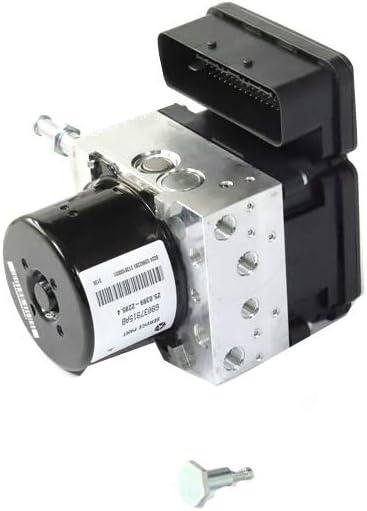If your car’s ABS light is on, it might be time to repair the ABS module. The anti-lock braking system is a crucial safety feature that helps prevent your wheels from locking up during sudden braking. You can fix common ABS issues yourself with a few basic steps.
Start by disconnecting the car battery to ensure safety. Remove the ABS fuse to stop the motor from burning out. After this, you can carefully take out the ABS module. Be sure to handle it gently and avoid damaging any other parts.
Once the module is out, check for common issues like faulty transistors and burned-out circuits. Sometimes just cleaning the module or replacing a small part can solve the problem. If you’re not comfortable doing this yourself, consider sending the module to a professional repair service.
Troubleshooting Your ABS System
Signs of a Faulty ABS Module
A faulty ABS module can manifest in several ways:
- ABS warning light: This is the most obvious sign. If it stays on, your ABS system needs attention.
- Brake issues: You might experience a spongy brake pedal, longer stopping distances, or the wheels locking up during braking.
- Diagnostic trouble codes (DTCs): A code reader can pinpoint the specific issue, often related to the ABS module.
Tools and Materials You’ll Need
- Code reader (OBD-II scanner)
- Safety glasses
- Wrench or socket set
- Screwdriver
- Electrical tape
- Multimeter (optional)
- Replacement ABS module (if needed)
Step-by-Step Repair Process
- Diagnose the Issue: Use the code reader to check for DTCs related to the ABS system. Note down the codes, as they’ll guide your next steps.
- Locate the ABS Module: It’s usually found under the hood, near the brake master cylinder. Refer to your car’s manual for the exact location.
- Disconnect the Battery: For safety, disconnect the negative terminal of the car battery before working on any electrical components.
- Remove the ABS Module: Carefully disconnect the electrical connectors and any brake lines attached to the module. Use the appropriate tools to unbolt and remove it from its mounting bracket.
- Inspect the Module: Look for signs of physical damage, corrosion, or burnt components. If any are found, the module likely needs replacement.
- Test the Module (Optional): If you have a multimeter, you can check the module’s electrical circuits for continuity. Refer to a repair manual for specific testing procedures.
- Repair or Replace: If the module is repairable, follow the instructions in a repair manual or take it to a professional. If not, install a replacement module.
- Reconnect Everything: Reattach the electrical connectors and brake lines. Tighten all bolts securely.
- Bleed the Brakes: After reconnecting the brake lines, bleed the brakes to remove any air bubbles that might have entered the system.
- Reconnect the Battery: Reconnect the negative terminal of the car battery.
- Test the System: Start the car and check if the ABS warning light turns off. Take the car for a test drive on a safe, empty road to ensure the ABS system is working correctly.
Safety First!
Remember, working on your car’s braking system requires caution. If you’re not comfortable with the process, it’s always best to consult a qualified mechanic.
Understanding Your Vehicle’s ABS System
The ABS (Anti-lock Braking System) helps to keep a car’s wheels from locking up during braking. This ensures better control and safety, especially on slippery surfaces.
Components of the ABS Module
The ABS system features several key parts:
- Control Module: The brain of the ABS. It manages data from the wheel speed sensors.
- Sensors: These are positioned at each wheel to monitor speed.
- Pump: Restores hydraulic pressure needed for braking.
- Valves: Control the pressure to each brake.
Each part works together to prevent wheel lock-up and ensure stability.
Symptoms of ABS Module Failure
A failing ABS module can show many signs:
- ABS Warning Light: If this light appears on the dashboard, it often means a problem with the ABS module.
- Pulsing Brake Pedal: The brake pedal may pulse or vibrate when pressed.
- Loss of Braking Power: You might notice weaker brakes.
If these symptoms are visible, it’s important to check the ABS system quickly.
Safety Implications of a Malfunctioning ABS
When the ABS isn’t working, safety is compromised. The wheels might lock up during braking. This makes it easier to skid or lose control. On slippery roads, there’s a higher risk of accidents or hydroplaning if the ABS fails. Regular checks ensure the system works properly, keeping everyone safe on the road.
How to Repair or Replace the ABS Module
Repairing or replacing the ABS module involves diagnosing the problem, following a step-by-step repair process, and considering the costs and maintenance tips. This section helps you understand what to look for and how to manage repairs or replacements effectively.
Diagnosing ABS Problems
A common sign of ABS problems is the ABS light on the dashboard. You might also notice the brakes lock up during sudden stops. Using a scan tool can help identify issues like faulty wheel speed sensors or problems with brake pressure. Pay attention if the check engine light turns on too. If you notice frequent problems or poor braking pressure, you may need to look deeper into the ABS unit.
Step-by-Step Repair Procedure
- Disconnect the Battery: Always start by disconnecting the positive cable from the battery.
- Use a Scan Tool: Connect the scan tool to the vehicle and find out the problem codes.
- Inspect the ABS Module: Check all connections and the module itself for signs of damage or corrosion.
- Remove the ABS Module: If you need to replace it, take the ABS module out. This sometimes includes the connected solenoid block and motor.
- Replace or Repair Components: If replacing, install the new module and make sure it’s properly secured. For repairs, fix any damaged parts like transistors or pins.
- Reconnect Everything: Once finished, reconnect the battery and test the system to make sure the ABS light goes off and the brakes work well.
Cost Considerations and Maintenance Tips
ABS module replacement costs generally range from $980 to $1,040. Parts alone can cost $870 to $900 while labor rates are typically $110 to $140. The cost can vary depending on vehicle type, how long the repair takes, and where you get the service.
For maintenance, regularly check the wheel speed sensors and keep an eye out for any signs of trouble like the ABS light coming on. If you see issues often, schedule a visit with a mechanic or autonation mobile services to get a professional opinion. Performing these regular checks can help avoid expensive repairs later.
Frequently Asked Questions
This section covers common questions about repairing or replacing ABS modules. It helps car owners understand what to expect and how to handle issues with their ABS systems.
What are the steps for replacing an ABS module in a vehicle?
- Disconnect the battery.
- Locate the ABS module.
- Remove the old ABS module.
- Install the new ABS module.
- Reconnect the battery.
- Test the system to ensure proper operation.
Where can I find a reliable ABS module repair service?
You can find reliable services at auto repair shops, dealerships, and specialized brake repair centers. Look for reviews online to find trusted options. Make sure to verify their experience with ABS systems.
How much is generally charged for repairing an ABS control module?
Repair costs can vary. On average, you might spend between $300 and $1,000. This can depend on the car model and the severity of the issue. Always ask for detailed quotes before proceeding.
Is it possible to perform an ABS module repair at home?
Yes, it is possible with the right tools and knowledge. Follow step-by-step guides and ensure you have the needed parts. If you are not confident, it’s better to seek professional help.
What is the average time required to complete an ABS module replacement?
The replacement typically takes around 1 to 3 hours. This can vary based on the vehicle and the mechanic’s experience. Plan for some additional time for testing the new module.
How do I troubleshoot an ABS module to determine if it needs repair?
- Check the ABS warning light.
- Listen for unusual noises.
- Use a diagnostic tool to scan for error codes.
- Inspect the module for visible damage.
- Test the braking performance.
By following these steps, you can find out if your ABS module needs repair or replacement.







